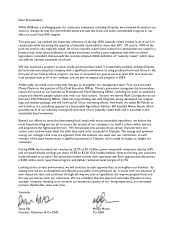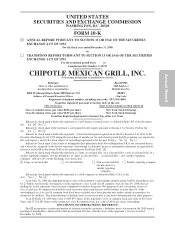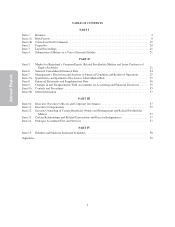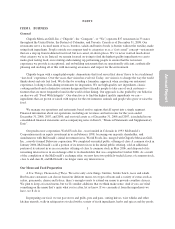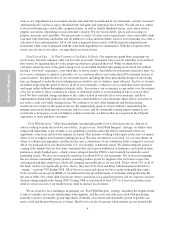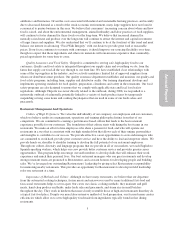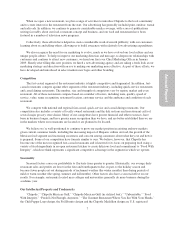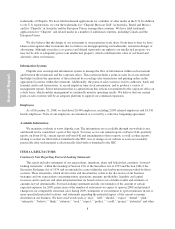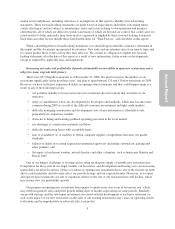Chipotle 2008 Annual Report Download - page 6
Download and view the complete annual report
Please find page 6 of the 2008 Chipotle annual report below. You can navigate through the pages in the report by either clicking on the pages listed below, or by using the keyword search tool below to find specific information within the annual report.
such as rice. Ingredients we use include chicken and steak that is marinated in our restaurants, carnitas (seasoned
and braised pork), barbacoa (spicy shredded beef) and pinto and vegetarian black beans. We add our rice, which
is tossed with lime juice and freshly chopped cilantro, as well as freshly shredded cheese, sour cream, lettuce,
peppers and onions, depending on each customer’s request. We use various herbs, spices and seasonings to
prepare our meats and vegetables. We also provide a variety of extras such as guacamole, salsas and tortilla chips
seasoned with fresh lime and kosher salt. In addition to sodas and fruit drinks, most of our restaurants also offer a
selection of beer and margaritas. All of our food is prepared from scratch, with the majority prepared in our
restaurants while some is prepared with the same fresh ingredients in commissaries. With the exception of the
sweet corn for one of our salsas, our ingredients are never frozen.
Food Served Fast … So That Customers Can Enjoy It Slowly. Our employees spend hours preparing our
food on-site, but each customer order can be ready in seconds. Customers select exactly what they want and how
they want it by speaking directly to the employees that have prepared the food. While we think that our
customers return because of the great-tasting food, we also think that they like getting food served fast without
having a “fast-food” experience, even when they’re not in a hurry. And while our restaurants often have lines, we
try to serve customers as quickly as possible; we’ve even been able to serve more than 300 customers an hour at
some locations. The natural flow of our restaurant layout, including the floor plan and the design of our serving
line, are designed to make the food ordering process intuitive and, we believe, more efficient. And we’re focused
on further improving the speed of service in all of our restaurants, so that we can accommodate more customers
and larger orders without disrupting restaurant traffic. For instance, our restaurants accept orders over the internet
or by fax in order to allow customers in a hurry or with large orders to avoid standing in line to wait for their
food. We have installed change machines at the cashier station in virtually all of our restaurants, and have
implemented a hand-held point-of-sale terminal in a small number of our restaurants which allows customers to
pay with a credit card while waiting in line. We continue to review other equipment and kitchen design
modifications to improve the speed of service. By emphasizing speed of service without compromising the
genuine interactions between our customers and our crews, and by continually making improvements to our
restaurants to keep pace at even our highest-volume restaurants, we believe that we can provide the Chipotle
experience to more and more customers.
“Food With Integrity.” More than anything, serving high quality food is what motivates us. And we’re
always looking to make the food we serve better. As part of our “Food With Integrity” strategy, we believe that
using fresh ingredients is not enough, so we spend time on farms and in the field to understand where our
ingredients come from and how the animals are raised. This includes working with experts in the areas of animal
ethics to try to support more humane farming practices. Because our menu is so focused, we can concentrate on
where we obtain each ingredient, and this has become a cornerstone of our continuous effort to improve our food.
All of our pork and all of our chicken in the U.S., for example, is naturally raised. We define naturally raised as
coming from animals that are fed a pure vegetarian diet, never given antibiotics or hormones, and raised in open
pastures or deeply bedded pens—which is more stringent than the USDA’s new standard for naturally raised
marketing claims. We also serve naturally raised beef in about 60% of our restaurants. We’re also investigating
the use of more sustainably grown produce, meaning produce grown by suppliers who we believe respect the
environment and their employees, while still charging reasonable prices for our food. Today, about 35% of all of
the beans we buy are organically grown—that is, they meet U.S. Food and Drug Administration standards for
“organic”- up from 30% during 2008. All of the sour cream and cheese we buy is made from milk that comes
from cows that are not given rBGH, or recombinant bovine growth hormone, to stimulate milk production. By
the end of 2008, 10% of the milk used in our cheese came from cows raised in pastures and we expect to increase
that percentage significantly during 2009. During 2008 we purchased at least 25% of at least one produce item
while in season in each of our markets from small to midsize local farmers.
We do, however, face challenges in pursuing our ‘Food With Integrity’ strategy, including the length of time
it takes to identify and secure relationships with suppliers, and the costs and risks associated with purchasing
naturally raised or sustainably grown ingredients. Naturally raised meat and sustainably grown vegetables are
more costly and the growth process is longer. Herd losses can also be greater when animals are not treated with
4
Annual Report


